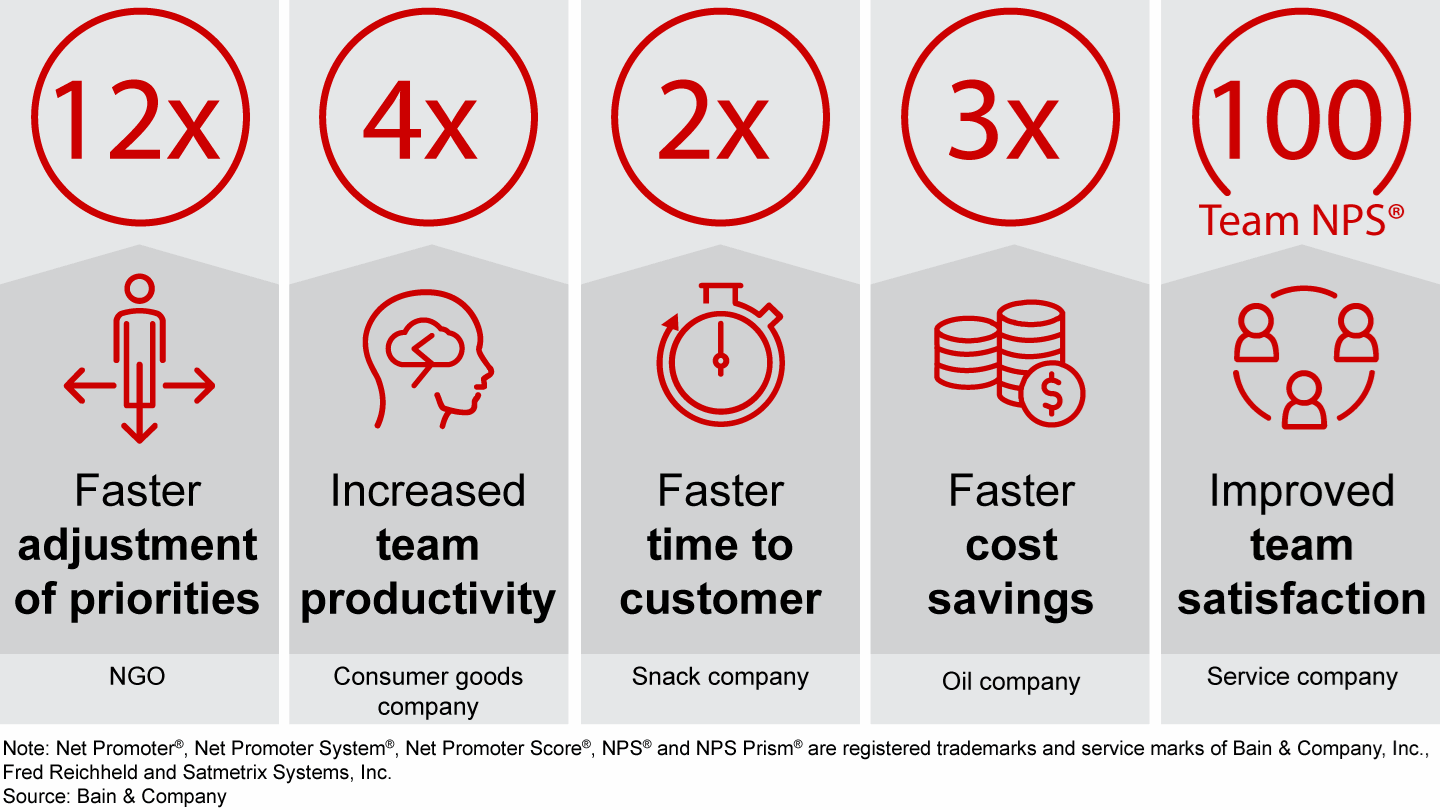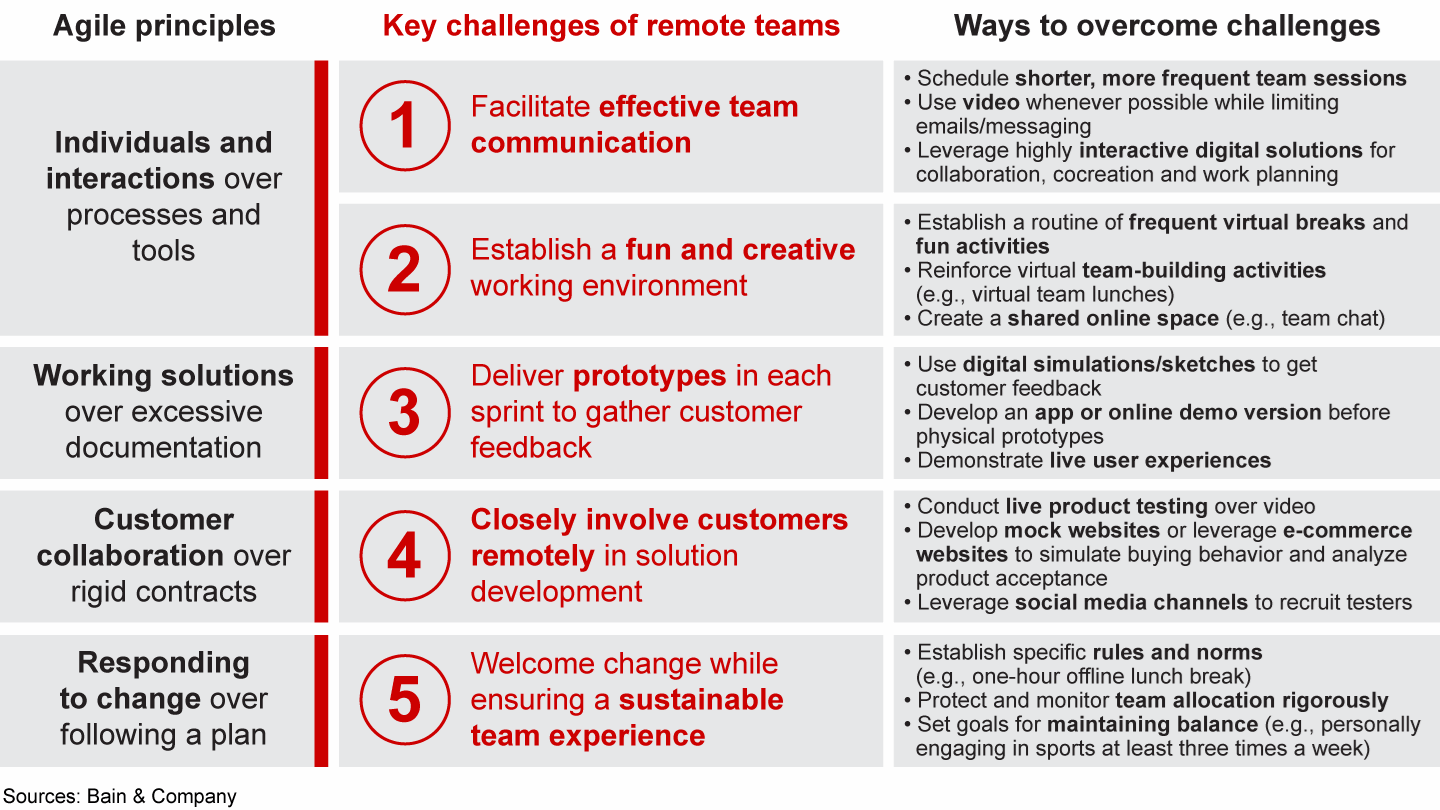Brief

Executive Summary
- Remote Agile teams need to overcome five key challenges: communication, team connection, prototyping, customer feedback and team sustainability.
- The success of remote Agile teams during the Covid-19 pandemic suggests that in the future companies would benefit from combining the best of physical and digital Agile collaboration.
Agile teams work extraordinarily fast in iterative sprints. Focus and communication are critical to their success. Before Covid-19 there was a common perception that Agile teams needed to be face-to-face to work effectively and get results quickly.

Macro Surveillance Platform
For more detail on the business implications of coronavirus from Bain’s Macro Trends Group, log on to the Macro Surveillance Platform. Learn more about the platform >
So when Covid-19 arrived, moving about three-quarters of white-collar workers into remote setups, many executives assumed their Agile teams would be put on pause. Some, however, decided to test whether their teams could work remotely. The early results are now in. While some industries adapt more easily to remote work of all types, growing evidence shows that today across a variety of industries remote Agile teams are succeeding (see Figure 1). They are doing so in different parts of the globe and while working on a variety of different projects.
Agile teams pushed remote by Covid-19 are succeeding


Data from the Standish Group shows that in typical times Agile teams are as much as twice as effective as non-Agile teams. Recent experience suggests that Agile’s advantage actually expands when teams work remotely. One reason for this may be that the things that make traditional ways of working challenging—lack of prioritization, multitasking and unclear decision-making—are even bigger problems when a business goes virtual. By contrast, Agile’s clearly defined roles, events, artifacts and timing become even more valuable.
The greater their geographical distance, the more time zones become an issue, but Agile software development teams have been working this way for decades. Over that time, they have developed a sophisticated set of tools for working together in a virtual environment, getting customer feedback on prototypes and managing shifting priorities in a way that is visible to the entire team.
Remote Agile teams face five critical challenges: communication, team connection, prototyping, customer feedback and team sustainability (see Figure 2).
Remote Agile teams face, and must overcome, five critical challenges


Facilitating effective communication
Distributed Agile teams need to accelerate communication, and do so by scheduling more frequent (though shorter) team meetings. Video and interactive digital collaboration and cocreation tools help, as long as team members are comfortable with them. Teams should not load up on fancy tools, but start with the minimum viable set and expand as needed.
When a global oil company had to run a recently launched Agile innovation team remotely because of Covid-19, management initially considered canceling the project. Instead, they gave virtual collaboration a shot. The nine-member cross-functional team conducted classic Agile practices such as the 15-minute morning stand-up and sprint review meetings via video. They collaborated using Zoom for videoconferencing, Trello for planning and prioritizing work, and Power BI dashboards to store key data. A centralized repository of data that people across the company could access was created. And the team quickly showed they could effectively work remotely, identifying and delivering cost savings at three times the rate of traditional approaches.
Improving connection by establishing a fun and creative working environment
Virtual Agile teams can improve connection with team-building activities such as virtual coffees or games. Instituting a shared online space, a team chat room where everyone can post questions and get input, is also helpful. When a service company needed to develop a new CRM software despite Covid-19, a remote Agile team used virtual happy hours and cooking classes to nurture a strong environment. Their efforts were such a success that team members gave the project a Net Promoter Score® of 100. Reflecting the remarkable moment we are all in, remote Agile team members at a global snack company highlighted feeling more empathy and a greater recognition of one another’s vulnerability. One reason: seeing peers and managers in their home environments, dealing with common challenges like restless children and other Covid-19 stresses.
Virtually prototyping in each sprint and gathering customer feedback
Soliciting customer feedback on digital simulations or sketches is helpful since products are typically designed on the computer before the first physical prototype is built. This helped an Agile team at a consumer goods company develop in just two weeks a minimal viable version of a real-time dashboard for recommending marketing investments. The speed reflects an increase in team productivity of approximately four times.
Closely involving customers in solution development
Remote Agile teams can connect with customers using a number of techniques including live product testing over video, virtual interviews and feedback, and workshop sessions to remotely observe customer experience and preferences. There are also methods for distributing products through the mail and inviting video feedback. Developing mock websites or leveraging e-commerce websites makes it possible to simulate buying behavior and helps teams analyze product acceptance. A remote Agile team at an NGO recently invited their leadership to help them assess user experience by trying the old and new software live. They then ran subsequent sprint reviews with customers to get their feedback. The process helped them adjust team priorities 12 times faster than usual despite working from home.
Ensuring a sustainable team experience
The lines between work and private life are blurring. To make sure remote teams can endure and succeed, some are instituting offline lunch hours and other breaks while also rigorously monitoring the time members are allocated to the team. An Agile team developing a new product for the global snack company set express goals for maintaining balance, like personally engaging in sports at least three times a week or having dinner with the kids every night. And their results were outstanding, developing a new product in half the usual time.
The future of Agile teams
Are widespread distributed teams something temporary that must be tolerated? Or is this forced Covid-19 experiment teaching us something important about distributed teams, something that might permanently change parts of the Agile process?
It is unlikely that remote Agile teams will remain the norm once the Covid-19 pandemic has subsided. There are just too many benefits to in-person creation, collaboration and communication. But as we are seeing, there are also advantages to remote teams. They can be pulled from a broader talent pool, are less expensive to run and can advance digitalization within an organization, among other things.
Running remotely, Agile teams have become comfortable with many tools and practices that can benefit colocated teams as well. Virtual collaboration tools (Microsoft Teams, Slack), videoconferencing (Zoom, Webex), collaborative whiteboards (Miro, Mural), virtual polls (Poll Everywhere, Qualtrics), work plan management (Jira, Trello), and ways of capturing the voice of the customer or employee (Remesh, Waggl) are now familiar to these teams. Their benefits proven, use by all teams is likely to grow.
Agile teams shouldn’t just revert to the pre-Covid-19 ways of working. Rather, they can adopt the best of both physical and digital collaboration very much as traditional retailers have adopted omnichannel strategies to combine the best of both worlds.
There will always be companies and situations for which colocation is difficult. In the past, those companies may have resisted working in Agile. They will certainly reconsider that position now. The current crisis has clearly shown that Agile ways of working help individuals, teams and companies more effectively cope with changing circumstances and unknowns. And that’s a lesson to remember.
Net Promoter®, Net Promoter System®, Net Promoter Score®, NPS® and NPS Prism® are registered trademarks and service marks of Bain & Company, Inc., Fred Reichheld and Satmetrix Systems, Inc.

Coronavirus
The global Covid-19 pandemic has extracted a terrible human toll and spurred sweeping changes in the world economy. Across industries, executives have begun reassessing their strategies and repositioning their companies to thrive now and in the world beyond coronavirus.